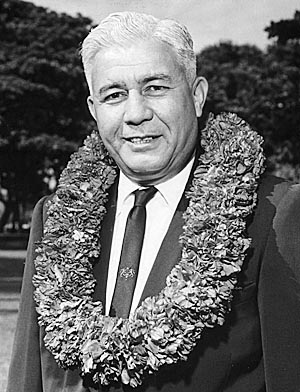Abraham Pi'ianai'a
By Karen Blakeman, Advertiser Staff Writer. Posted on Sunday, February 9, 2003.
"Abe was a very special person," said Pi'ianai'a's student and longtime friend, Lehman "Bud" Henry, a retired geographer. "He was my mentor, that's what he was. He was well respected by everyone."
Pi'ianai'a will be remembered for his work as an educator, beginning in the 1950s as a teacher of the Hawaiian language at Kamehameha Schools and continuing for 40 years as a lecturer in geography, history and Hawaiian studies.

Abraham Pi'ianai'a. Advertiser Photo
Pi'ianai'a was chairman of the program in Hawaiian Studies at the University of Hawai'i, and his work has helped to perpetuate the Hawaiian culture.
At age 70, in 1985, he was a crew member aboard the Polynesian voyaging canoe, Hokule'a. He served under his son, Captain Gordon Pi'ianai'a, and alongside his grandson, Chad, on that voyage.
In 1999, he was awarded the title of "Living Treasure" by the Honpa Hongwanji Mission of Hawai'i.
Pi'ianai'a was born near a waterfall at Waikahalulu, on Nu'uanu Stream, on June 15, 1915, his family said. He graduated from Kamehameha Schools in 1933.
In 1935 and 1936, he became a pioneer member of Hui Panala'au, a group of young men who moved to the strategically important Line Islands of Baker, Jarvis and Howland as colonizers for the United States. The men, particularly in the first expeditions, lived a harsh existence far from Hawai'i. Pi'ianai'a led his peers in the first four expeditions.
Afterward, he became a Honolulu police detective, a job he held before and after World War II.
During the war, Pi'ianai'a went to sea with the U.S. Merchant Marine and quickly rose through the ranks. He made shipmaster, a designation equivalent to captain, in 18 months. He was qualified to command ships of all weights in any ocean.
In 1947, he became shipmaster of a fisheries research vessel owned by the Territory of Hawai'i. In that capacity, he conducted investigations and studies of the Hawaiian waters and reefs.
His seafaring life continued for many decades. Pi'ianai'a retired with the rank of commander in the U.S. Naval Reserve and later served as a shipboard lecturer on cruise ships.
OUR HONOLULU: Abe's art of native oratory
By Bob Krauss, Advertiser Columnist. Posted on Feb. 16, 2003.
They are laying Abe Pi'ianai'a to rest today. All the accolades written about him since he died are true: He was a pioneer of Hawaiian studies, teenage castaway, master mariner, police detective, Living Treasure and more.
There's something else that hasn't been mentioned. Abe was one of the last Hawaiian orators. Not a chanter, an orator. Hawaiian oratory is an art that should be revived, as the hula has been.
They say Sir Peter Buck, Te Rangi Hiroa, legendary director of the Bishop Museum, was a master orator. I'd have stacked Abe up against him any day because I heard Abe perform. It made me understand the levers of power in old Hawai'i.
It was when we were bunkmates on board Hokule'a in the Society Islands in 1985. Abe was 70 then, eight years older than I and in better shape. When he was sleeping, I had to be on deck and vice versa. I got really tired. He was as good as new.
A Tahitian cultural group invited the crew of Hokule'a to stay in their miniature Polynesian Cultural Center on Moorea: thatched Tahitian fales, meeting house, imu pit and kava ceremonial hall in a grassy clearing under palm trees.
We sailed over there and were met by a wiry little fellow in a malo, said to be the best orator on Moorea. He was a Christian minister so he had a lot of practice. He got up and delivered a fiery oration in Tahitian. Then Abe went to the front and answered him right back in Hawaiian.
I couldn't understand a word but I knew what was going on. It was a duel of champions. Kenneth Emory, the pioneer anthropologist, had told me about Polynesian oratory. This was the first time I'd heard the real thing.
Those Tahitians were entranced. You know how other Polynesians accuse Hawaiians of having lost their culture? Well, as a Christian minister, the Tahitian could only invoke Jehovah. When Abe rolled out Ku, Lono, Kane and Kaneloa, the mouths of the Tahitians dropped open.
This was followed by a kava ceremony, the Polynesian form of diplomacy, because the Tahitians wanted to build a voyaging canoe and were eager to get started. But they were starry-eyed with romantic notions. Abe handled it perfectly.
First he introduced Mau Piailug, master navigator, who had sailed by the stars all his life. Then Nainoa Thompson, eight years of training. Next came Gordon Pi'ianai'a, Abe's son, captain on the voyage, who holds a master's license for any size ship in the world.
In this diplomatic way, Abe explained to the Tahitians how much they had to learn. I'm not sure they understood but they called him Papa, the term of endearment for an old man. Abe said, "I'd better not tell my wife about my children in Tahiti."
That night, he was the first one in the crew to walk on fire in the purification ceremony. I'd have never tried it if he'd been afraid.
